Cover Story
Joe Garrison: Creating Jazz Magic with his Society of Friends
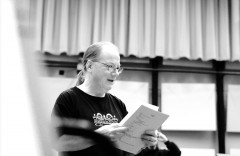
Joe Garrison
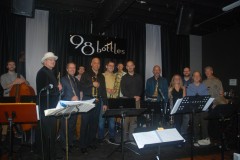
Book of Gratitude band members. Photo by Veronica Cruz.
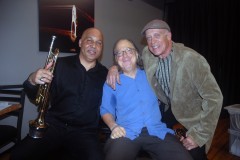
Garrison with Derek Cannon (left) and pianist Lynn Willard. Photo by Veronica Cruz.
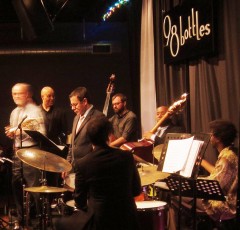
Gilbert Castellanos with Night People
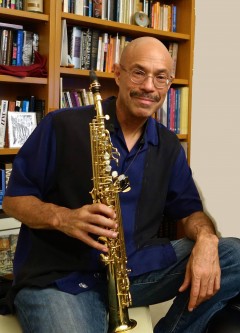
Kamau Kenyatta. Photo by Veronica Cruz.
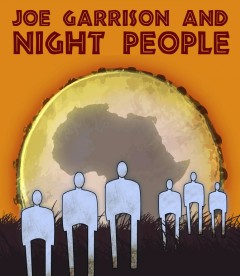
It’s a festive crowd at 98 bottles. Unusual for a Sunday, the place is packed. Every seat looks to be taken, and folks mill about the stage. Despite the size of the crowd, it seems as though everyone knows everyone else, like this is some sort of reunion. There are lots of smiles, lots of waves, and a whole bunch of hugs.
I find a chair and sit down. A waiter brings me a beer I didn’t order. It tastes good, so I don’t complain. Anyway, whatever beer I’m drinking it’s okay. I’m here for the music. On this November night, Joe Garrison and his mates performed the Book of Gratitude, one of the latest creations of this San Diego-based composer.
Members of the 12-piece ensemble ready themselves with some last glances at their sheet music and final tuning. Scott Paulson, the oboist, sports a snow white bowler and talks to a couple who sits at the front of the stage. On stage, besides the piano and drum set, are a set of congas; a bass clarinet rests on a stand.
With all the musicians in their places, Joe Garrison takes the stage. He is dressed in simple tan pants and an open collar shirt. Bespectacled, his light brown hair, with more than a touch of grey, falls in strands down to his shoulders. The life-long composer is not a big man, but he seems to stand tall in front of the other musicians on stage. As he speaks, he chokes up a bit, stops himself, and says, “If I keep going like this I’m going to cry.” He takes a breath. “This is the Book of Gratitude. This is about thankfulness. That’s what it’s all about. We’re all just thankful to be here.” And as he says, “thankful to be here,” it is apparent that he is speaking within a larger context, not just thankful to be at 98 Bottles but thankful to be alive and walk the earth.
The night of music begins with “Bodhisattva in Paris,” the first of the six suites that comprise Joe’s opus. Based on a Latin rhythm, the piece is somewhat breezy and bouncy, with differing musical motifs advancing one after another. Featuring the playing of the ensemble, the solos are short. “River of Light and Air,” the second movement, starts off with a Stravinsky-esque theme that evolves from a Latin groove to a rocking groove. Garrison is full of energy. His conducting style is that of an excited little kid; he is totally in the moment. The music drives stronger and stronger until the piece culminates in a final chord of dissonance.
Joe Garrison has been described as San Diego’s underground composer. While there doesn’t seem to be anything in particular subterranean about his music, he most certainly is not a household name. That anonymity might be fading away in the near future. The ensembles he creates to perform his compositions — all of which, no matter if they are sextets, nonets, or 16-piece bands, are called Night People — have been receiving enthusiastic responses from audiences at the Loft at UCSD, Dizzy’s, and 98 Bottles. His release last year of Veranda, a CD containing six compositions for Night People has been called “bold” and “original,” and has received a warm reception in the music world.
For years Garrison has been heralded for his skill as a composer, with his works being described alternately as “intricate” and “visceral.” People also use the words “power” and “finesse” when they describe the music Garrison creates. At times his music reminds me of the more exploratory work of Duke Ellington or of the textures and colors achieved by Charles Mingus and his bands. When Garrison talks about his influences, he lists Monteverdi, Stravinsky, and the very experimental Harry Partch. “Other absolute heroes are Leonin and the guys who wrote the Notre Dame Organum,” he says. “Also, Hector Berlioz is the patron saint of anybody who writes music and produces it themselves!”
He does not wait for a muse to inspire him to commit notes to an empty staff. He writes music whenever he finds time in his busy schedule, the way the rest of us might read a novel or work on a sudoku puzzle between chores and errands. Garrison confesses, however, that once he gets on a roll, inspiration can keep him going throughout the night. “Once I start a piece, I tend to stay at it until it’s done, like a dog with a bone. I can do 14-hour days, easy.”
As he has written music for over 25 years, albeit with a couple four or five year-stretches in which he wrote no music, Garrison has amassed a large compendium of music. “I write a lot of stuff that doesn’t work. Stacks of it. And [I’ve had] lots and lots of false starts. The trick is never get married to anything you write. If it’s terrible, so what? Ray Bradbury said, ‘Write a short story every week. It’s not possible to write 52 bad short stories in a row.’”
The rest of the evening at 98 Bottles is filled with textured harmonies that flirt with differing levels of dissonance. Featured soloists were Kirk Johnson on flute, Kamau Kenyatta on soprano sax, Derek Cannon on trumpet and flugelhorn, Lynn Willard on piano, Chris Duval on bass, and David Castenada on congas. The rest of the ensemble was rounded out by Scott Paulson on oboe, Ian Tordella on clarinet, Bryan O’Donnell on trombone, Michael Hayes on drums, and Steve Solook on percussion.
Garrison’s immersion into music goes back to when he was a small child. The San Diego native, along with his brother and two sisters, grew up in a home where music was prized. His maternal grandmother was a gifted pianist, particularly when it came to playing old-style stride piano. His mother required all of her children to play a musical instrument.
“All of them, my sisters and brother, are really good musicians,” says Garrison. One sister excels at a number of distinct artistic endeavors. She draws, paints, and plays the piano. His other sister threw herself into the piano and for a time contemplated becoming a concert pianist. His brother is a self-taught guitarist who plays everything from baroque recorder music, to Bach, to the Allman Brothers. “He’s a really good musician and has one of the best sets of ears on anybody I’ve ever known. He could always take anything off records with no training. And he makes a real point to get the vibe of what he’s playing.”
A graduate of San Diego High School, Garrison remembers picking up —Â at various times — the flute, the clarinet, the trumpet, and the piano, all of which he admits did not receive the amount of practice that they should have. But that all changed once Garrison got his hands on an electric guitar. With a Sears knock-off guitar and a Sears Silvertone amp, the young Garrison was ready to rock and roll. “I discovered the wonderful world of feedback,” he says, reminiscing of the days when the guitar ruled the world of popular music. Whereas his parents would implore him to practice the piano or the trumpet, they now would take his guitar away from him when they wanted to punish him.
He played the guitar, as well as the bass, in his high stage band. At the age of 13, with a band called the Cobras, and later called the ID, Garrison hit the world of rock ‘n’ roll. “My first paying gig was when I was 13. We played for four hours. That band played all sorts of places.
“I really grew up in that band, too.” he says, as he talks about the old days when all the music stores were in downtown San Diego and when the area now known as the Gaslamp District was filled with peep shows and other attractions for young sailors. “I was really innocent to all that when I would go down to those music stores. I had no idea what that was all about, the places with the girls’ pictures on the front of them,” he adds with a laugh.
Then Garrison’s frenzy of feedback and life of rock and roll came to a screeching halt. In 1969, trying to devote himself more to understanding music and learning to compose, he stopped listening to rock ‘n’ roll. “I didn’t hear Steely Dan till decades later,” he says ruefully.
Determined to learn how to write music, Garrison studied orchestral scores. It was time for him to roll up his shirt sleeves and dive into the works of the great masters. And this was a full-on autodidact operation. He had no instructors and was not taking any classes in composition, at least not yet. “I would listen to the music and try to see what it was in the score,” he says. “I would listen to a piece of music and see how the composer was doubling the clarinet and the flute, or that the cellos and basses were written in octaves. I could see the development, too. There were certain ways that Mozart put things together, and I saw the techniques that Beethoven used.”
He studied music at UCSD. Though Garrison’s music is modern, he felt that the emphasis on the avant garde, which is characteristic of the music department at UCSD, wasn’t giving him enough of the basics that he needed. He transferred and finished up with a bachelors at Cal State Fullerton. He then studied at the University of Colorado, earning a master’s degree in composition.
As Garrison admits, there is no money in music, and possibly even less in writing music. He has hence earned a living through a number of pursuits. He has been a teacher, a gardener, and for ten years, until computers sent the trade the way of the horse and buggy, Garrison worked as a music typesetter. Currently, his day job is tuning pianos. Working throughout San Diego County, he tunes pianos for schools and performance spaces, as well as in people’s homes. An associate member of the Piano Technicians Guild, Garrison has tuned the pianos of several notable musicians. He has tuned pianos for Wynton Marsalis; he has also tuned instruments for pianist Ahmad Jamal.
Garrison claims that he learned piano only well enough to communicate his ideas to other musicians, but he is actually a pretty good pianist. He has performed with Ira B. Liss’ Big Band Jazz Machine; the world music ensemble Kokopelli; as well as notable San Diego performers Rob Thorsen, Dave Millard, and the late Daniel Jackson. He has performed as a duo, called Direct from the Source, with trumpeter Burnette Anderson. He has also performed with the ensemble TIKAL.
A week or so after the performance at 98 Bottles, Garrison spent some time with me going over the score. We sat down at a cafe and he opened up what looked like an old bookkeeping ledger. Inside were page after page of musical staffs filled with notes. “See, here I started this piece with a theme that I heard in my head being played by a flute,” he says as he points to a staff and shows me a three-bar line. As he follows along the line with his pencil he sings the line softly. “You see that, that’s what all this is built around.” He shows me how that line is doubled in other instruments. He points to other places in the score where the double bass and the bass clarinet play the same line and at other places where the two instruments diverge.
Garrison does not compose music in what is called functional harmony. Functional harmony is used in most jazz and a great deal of popular music. Without getting too complicated, functional harmony dictates how chord sequences advance and gives a song or a jazz tune its sense of forward motion. Instead Garrison will explore how chords sound in and of themselves. In our conversation he talks about sharp 11th notes and minor ninth notes, and I have to confess that it wasn’t long before my head was spinning in confusion. “I’ve grown more harmonically mature and rhythmically complex from some of my earlier compositions,” he says.
“I will hear something in my head. Then after that it’s an open book. The music might take a turn, and I think, ‘That’s not where I heard it going.’” With a bemused look on his face, Garrison says, “I think of myself as an orange tree.” He recognizes the quizzical look on my face before I can blurt out a follow-up question. “Orange trees make oranges. That’s what they’re meant to do. I’m meant to compose music. It’s as simple as that. There is no ego in this. There can’t be. You need to open your mind as wide as the sky. You have to let yourself be surprised all the time. Like with the Book of Gratitude, I felt like the music was already written. If you think about it, everything is already here.” He jestures with his arms raised, indicating the earth and heavens. “Nothing is created or destroyed, It just takes different forms according to who is working with it. For a painter, he paints; a musician takes that same energy and makes music. Somebody who makes beer, makes beer.”
The act of composing comes easier for Garrison if he has a specific musician or ensemble in mind to write the piece for. If he knows the musician or group, he’ll have an idea of the talents that those performers bring to the table. “Percussionist Steve Solook asked me to write a piece for him. Thinking of his amazing abilities gave me ideas I never would have thought of otherwise. He holds a groove on drum, mainly bass drum set and high hat, while playing vibes. If anybody can do it, it’s one of those UCSD percussionists like Steve. I also work with Chris Warren, a Ph.D. in computer music at UCSD. The electronics from Chris Warren are just spectacular. He has ears that won’t quit.”
For the Book of Gratitude Garrison says that much of the input for its creation rests with Kamau Kenyatta. “Kamau suggested I write for orchestral instruments like flute, bass clarinet, and oboe. Once I started working with those sounds — in combination with a rhythm section — they almost told me how to write for them. The instruments determine how you write. Also, if you know the people who are going to play them, you can write specifically for them. For instance, Ariana Warren — she can read anything. Writing for her and these other fantastic players like Kamau, Ian Tordella, Charlie Arbelaez, Kirk Johnson, Scott Paulson, Brian O’Donnell, Derek Cannon, Lynn Willard, Doug Meeuwsen, Jordan Morita, Kevin Esposito, Bryan Smith, Doug Walker, Chris Duvall, and Charlie Weller. I know their special talents, and I can write in a way that exploits and highlights them.
“I have another new book for violin, winds, brass, and rhythm. Writing for solo violin has taken me to completely new places. It’s been so revealing. The instrument has a completely different vibe from what I’m used to and it’s really suckered me in!”
As I mentioned before, some folks have called Joe Garrison an underground composer. This perception is due in large part to Garrison’s music rarely receiving the performances that it deserves. In the last few years, however, there have been a good number of Night People performances. Garrison is quick to thank Kenyatta for helping to get his music performed and recorded. “Before I met Kamau, I was like a stray dog. I was writing music, but I didn’t care about getting it out there. I didn’t care about the results. But I started working with him and he said, ‘You’ve got to get this music played.’” The Grammy Award-winning pianist and saxophonist not only urged Garrison to perform his music, but he also served as the producer for the Night People CD Veranda. “I also have to give a big shout out to Gilbert Castellanos, who also told me to get my music out there. He was the first to book us, too. He put his name behind us,” Garrison says.
At the cafe, Garrison and I finish our coffees and he closes the score for the Book of Gratitude. While we have been inside, the day has warmed up and sun streams through the windows. I thank Garrison for his time and showing me his score. “Hey, thank you, man!” he says. He looks out the window then back at me. “That’s what it’s all about. It’s about thankfulness.”






